Recreational vehicles have a long and illustrious history, with their roots in the horse-drawn wagon that was invented thousands of years ago. The world’s first proper leisure caravan dates from the late 19th century and the motorhome made its debut back in 1904. The first caravan club was established not long after, while the Tin Can Tourist Club, America’s original RV camper club, formed in 1919.
Expensive luxuries, the earliest RVs are all about exquisite craftsmanship and stunning good looks. Click or scroll through to take a trip down memory lane and discover some of the finest examples…
RV wonders of the ancient world

Marcus Cyron / Wikimedia Commons [CC BY-SA 3.0]
The first wagon is thought to have been created by the Sumer civilisation in Ancient Mesopotamia around the fourth millennium BC, not long after the invention of the wheel. Leisure travel is almost as old but didn’t take off until after 300 BC, when the Romans started building an extensive road network.
Tourism remained the preserve of the rich, who could afford to vacation at a villa by the sea or visit a far-flung shrine. From about the first century AD, the Roman elite travelled in carrucas dormitoriaes (sleeping coaches), where they could bed down on overnight journeys. This particularly handsome replica, which features bronze decorations, is on display at the Romano-Germanic Museum in Cologne.
Romani and Irish Traveller vardos

John Thomson / Hulton Archive / Getty Images
Horse-drawn carriages were de rigueur for overland trips during the Middle Ages and early modern period, though travellers ate and slept in coaching inns along the way. Carriages were first used as living spaces by Europe’s roving circuses, freak shows and menageries in the early 19th century.
The itinerant Romani and Irish Traveller communities were next to embrace these tiny homes on wheels, which they adopted en masse in the 1850s. This photo of a Romani family and their caravan – or Vardo – was taken in 1877 near an encampment in London’s Notting Hill.
Vardo RV inspiration

Ian Bottle / Alamy Stock Photo
Vardos were often vibrantly colourful, fabulously ornate and richly decorated, with traditional Romani and Irish Traveller symbols such as flowers, grapes and horses incorporated into the designs.
These beguiling horse-drawn vehicles were the inspiration behind the world’s first leisure caravan, which was commissioned by eccentric naval doctor and novelist William Stables in 1884 and completed the following year.
The Wanderer (1885): the world’s first leisure caravan

travelib history / Alamy Stock Photo
Enchanted by the nomadic Romani lifestyle and eager to explore the great outdoors, Dr Stables instructed the Bristol Wagon Works Company, the maker of the Pullman railway carriage, to build a luxury vardo resilient enough to transport him on a tour of the UK. Stables’ bespoke caravan reportedly set him back £300, which is around $40,000 (£32k) today.
Crafted from mahogany and maple wood, and painted black and gold, the 18-foot ‘Land Yacht’ Wanderer was kitted out with all mod cons, including a sofa bed, Rippingille cooking range, washing facilities, a bookcase, china cabinet and even several musical instruments.
The Wanderer: inspiration for the world’s first RV movement

The Caravan and Motorhome Club Collection
Stables set off on his grand tour in 1885, travelling in lavish style from his home in Berkshire all the way up to Inverness, together with a valet, cook, coachman, Newfoundland dog and cockatoo. The Wanderer was such an uncommon curiosity at the time, the valet had to cycle ahead to warn road users it was coming, while on occasion hostile onlookers pelted the vehicle with stones.
Over time, Stables became something of a celebrity, sparking the ‘Gentleman Gypsy’ fad, the world’s first RV movement. Despite the name, the fad attracted both men and women, who commissioned elaborate caravans to explore the UK, often with a coterie of staff in tow who slept in tents. They were basically the original glampers.
The Wanderer: restoration and current home

PA Images / Alamy Stock Photo
When Stables died in 1910, the Wanderer passed to his daughter Ottoline. It stayed in the Stables family until 1961 when the trailblazing vehicle was donated to the Caravan and Motorhome Club’s enviable RV collection, which is hosted by the National Motor Musuem.
The venerable caravan underwent a meticulous renovation over the 10 years leading up to the club’s centenary in 2007 and was the star turn at a Buckingham Palace event marking the milestone. Today, the 19th-century beauty resides in a specially converted station goods shed at the Broadway Caravan and Motorhome Club Site in Worcestershire.
Ford Model T Motor Caravan (1914): the world’s oldest surviving motorhome

Bonhams
The very first DIY motorhome was built in the US in 1904 according to Smithsonian Magazine, while the 1910 Pierce-Arrow Touring Landau is regarded as the first production motorhome. Sadly, no examples have survived, which brings us to the oldest existing motorhome…
This remarkable RV was built in the UK in 1914 for a member of the Bentalls department store dynasty. Constructed on a beefed-up Ford Model T chassis, the caravan body is the handiwork of Dunton of Reading, a company that was noted for its top-quality traditional vardos.
Ford Model T Motor Caravan: exquisite renovation

Bonhams
This RV was purportedly sold in the 1920s and abandoned some time after. It was eventually rediscovered in a sorry state in Shepperton near London and restored to its former glory over a four-year period during the 1970s by enthusiast Leo Smith and cabinet maker Robin Tanner.
The motor caravan’s second wind has seen it partake in rallies and historic vehicles shows, as well as a TV show with members of the British Royal Family in attendance.
Ford Model T Motor Caravan: recent Bonhams sale

Bonhams
The vehicle’s interior is just as delightful as its all-timber exterior. Wonderfully cosy, it sleeps four and features a leather sofa, wood-burning stove, velvet curtains and a Welsh-style dresser, along with brass lamps and other period touches.
It’s little wonder, then, that when the motor caravan came up for auction with Bonhams in September 2022, it went under the hammer for an impressive $79,400 (£63.3k), more than double the asking price.
Eccles Caravan (1926): the world’s first mass-manufactured trailer

National Motor Museum / Heritage Images / Getty Image
Pioneering UK caravan maker Eccles of Birmingham was the world’s first major trailer manufacturer. Inspired by the military trailers used in the First World War, the firm started making caravans in 1919 and was churning them out by 1922.
This surviving example dates from 1926.
Eccles Caravan: fine craftsmanship

Heritage Image Partnership Ltd / Alamy
Made with plywood and built over a wooden frame with a lantern-shaped roof, the Eccles Caravan of the 1920s was constructed with the utmost skill. Tudor-style diamond muntin windows lend the caravan a homely cottage vibe, while the shiny exterior paintwork adds an elegant note.
The Eccles Caravan retailed for £185, which translates to $11,700 (£9.4k) today. By way of comparison, the typical house back then cost £619, around $39,000 (£31.3k) in 2024 money.
Eccles Caravan: posh interior

Karen Roe / Flickr [CC BY 2.0]
The inside is posher still. The interior panels and furniture were French polished to perfection and amenities included a stove and gramophone.
This specific model found its way into the collection of Caravans International founder Sam Alper before it was bought in 1980 by the National Motor Museum. It forms part of the institution’s core collection and is on permanent display.
Pierce-Arrow Fleet Housecar (1928): luxury custom motorhome
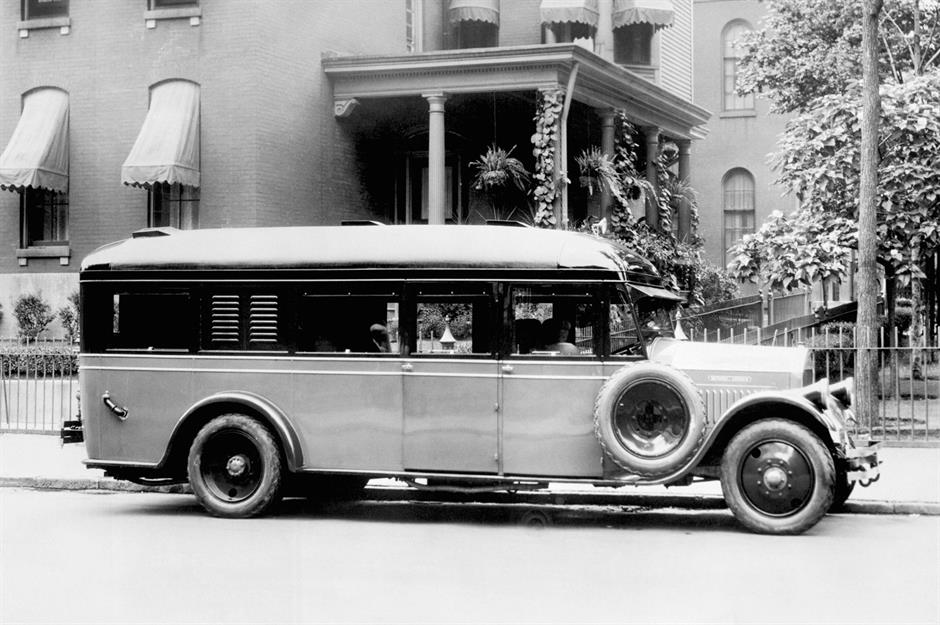
Underwood Archives, Inc / Alamy
Across the pond, covered Conestoga wagons transported families through the Midwest during the early part of the 19th century. But RVing as a leisure activity in the US originated in the late 1900s, and as we’ve mentioned, the very first motorhome was built in 1904, while luxury Buffalo, New York-based automaker Pierce-Arrow manufactured the first production motorhome in 1910.
In 1928, the firm introduced the Privateer Housecar. By this time, America’s first RV club had formed and RVing was becoming ever more popular in the country, though it was still a niche activity largely restricted to the well-off.
Pierce-Arrow Fleet Privateer Housecar: wow-factor status symbol

Craig Larcom / Alamy
The last word in high-end Roaring Twenties motorhomes and a wow-factor status symbol, only three Privateer Housecars were ever made and this is the only surviving example.
While pricing remains a mystery, the Privateer is likely to have cost many hundreds of dollars or might have even ran into the thousands, leaving it out of reach for most Americans at the time.
Pierce-Arrow Fleet Privateer Housecar: packed with amenities

sf-dvs / Flickr [CC BY 2.0]
Pierce-Arrow didn’t scrimp on the amenities, installing a kitchen and dinette, a bathroom with a toilet and shower, as well as other conveniences.
The history of the surviving model is sketchy. It somehow ended up in the antique vehicle collection belonging to Old State Prison in Montana, but is now owned by the RV / MH Hall of Fame in Elkhart, Indiana.
Home from Home (1929): Australia’s oldest surviving motorhome

State Library of South Australia [Public domain]
Australia was late to the RVing craze. This was a consequence of the vast country’s poor roads, long distances and lack of tourism infrastructure, as noted by RV historian Andrew Woodmansey.
Yet when Australians finally got the RV bug, they leapfrogged straight to motorhomes instead of tent tailers and caravans, which became popular later. Among the first Australian motorhomes is the adorable 12-foot Home from Home, which appears to be the oldest surviving example.
Home from Home: cottage on wheels

InnoventionAustralia / Flickr [CC BY-SA 2.0]
Modelled after a cute cottage with a red pitched roof, painted brick-effect walls and a chimney, the vintage RV certainly lives up to its name.
Home from Home was built in 1929 atop a 1924 Dodge Tourer by inventor Gerhard ‘Pop’ Kaesler of Nuriootpa, in South Australia’s Barossa Valley. It provided accommodation for Kasler and his family during their trips along the state’s coastline.
Home from Home: saved for posterity

South Australian History Network / Flickr [Public domain]
Kaesler created a comfy interior with amenities such as a stove, beds, wardrobes and a wireless.
Home from Home was later sold to Goolwa Mayor Percy Wells, reports Adelaide AZ. Following his death, it was donated to the Goolwa district council. Neglected for a long period during which it was vandalised, the motorhome was saved in the 1970s by the National Trust of Australia and extensively restored. The early RV is now on display at the Goolwa Museum.
Curtiss Aerocar (1932): Depression-era luxury RV

Jim Griffin / Flickr [Public domain]
The Wall Street Crash of 1929 and ensuing Great Depression battered the USA’s burgeoning RV industry, with trailers and motorhomes viewed as frivolous indulgences at a time when many Americans could barely afford to put food on the table.
Manufacturers did continue to make luxury RVs, but on a smaller scale. Among the standouts from the era is the Curtiss Aerocar. Early US trailers such as the Earl Travel Trailer from 1913 were traditional in design, resembling classic vardos or Victorian carriages, much like the Eccles Caravan.
Curtiss Aerocar: ultra-modern design

Hyman Ltd.
By the 1930s, American RV design had come on leaps and bounds, with a new generation of ultra-contemporary models rocking sleeker, starker forms influenced by fashionable Art Deco and Streamline Moderne, as well as aviation design. The Curtiss Aerocar epitomised this new breed of RV.
The fifth-wheeler was first produced in 1928 by the Curtiss Aerocar Land Yacht company headed by Glenn Curtiss, an aviation pioneer and former Wright Brothers rival. All in all, around 300 models were made but only 12 are thought to have survived. This example in glossy red dates from 1938 and was made for intrepid adventurer and Broadway actor Augustus Post, who also ordered the custom Chevrolet HC 1-ton truck to tow it.
Curtiss Aerocar: state-of-the-art features

Hyman Ltd.
Based on price info for other models from the time, the RV is likely to have cost the equivalent of $62,000 (£49k) today, or thereabouts. Loaded with amenities, this particular Aerocar is divided into two compartments and features aircraft-style seating, Pullman-esque bunks, a clock, altimeter and closet, as well as a full kitchen with an icebox and three-burner stove. There’s also a bathroom on board with a toilet and shower, a rarity in RVs of the period.
After Post, the Aerocar and Chevrolet’s owners have included Los Angeles’ Biltmore Hotel and Hollywood stuntman Robert “Wolf River Bob” Breeze. The combo was last sold in 2013 through renowned St Louis dealer Hyman Ltd. The price was undisclosed but is likely to have been substantial, given the combo was listed by Hemmings for $250,000 (£198k) in 2009.
Pierce-Arrow Model C Travelodge (1936): upscale metal trailer
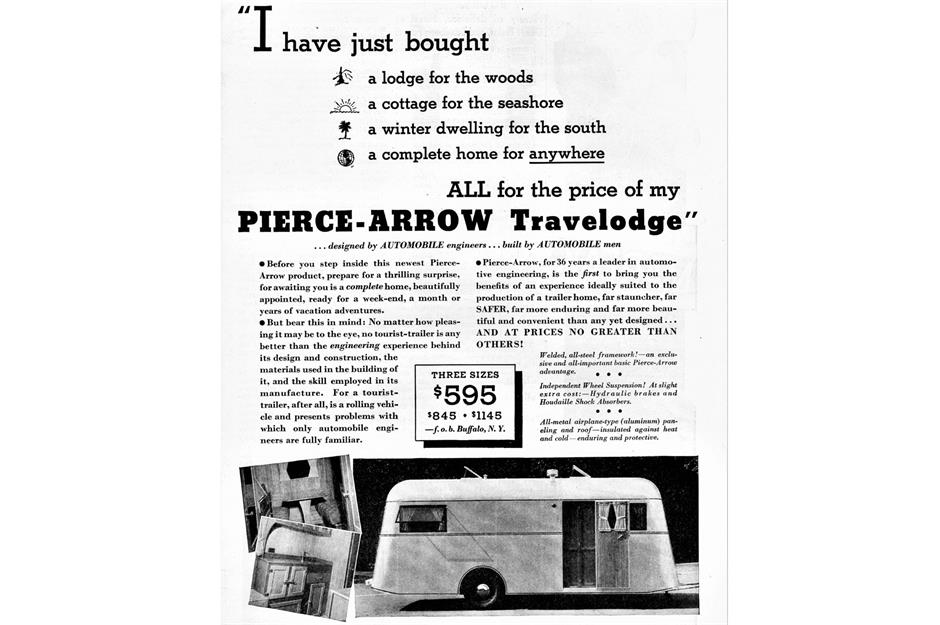
Alden Jewell / Flickr [CC BY 2.0]
Sales of Pierce-Arrow’s luxe automobiles and motorhomes floundered during the Great Depression. In a bid to stay afloat, the Buffalo-based carmaker started producing a line of upscale trailers, introducing the Travelodge in 1936.
Available in three sizes, the smallest 13.5-foot Model C version was priced at $595, which translates to $13,000 (£10.4k) in 2024.
Pierce-Arrow Model C Travelodge: engineering excellence

Darin Schnabel ©2019 Courtesy of RM Sotheby’s
Admired for its sturdiness and exceptional quality, the trailer was fashioned from aluminium over a steel frame, while its birchwood interior was decked out with a spacious dinette, as well as an icebox, camp and wood burning, stoves, plus other premium amenities.
All in all, 440 Travelodge trailers were produced in 1936 and 1937, including 74 Model C units, though just 20 are thought to have survived, including this pristine example from 1937 that sold via RM Sotheby’s in 2020 for $44,800 (£35.7k).
Pierce-Arrow Model C Travelodge: collectors’ item
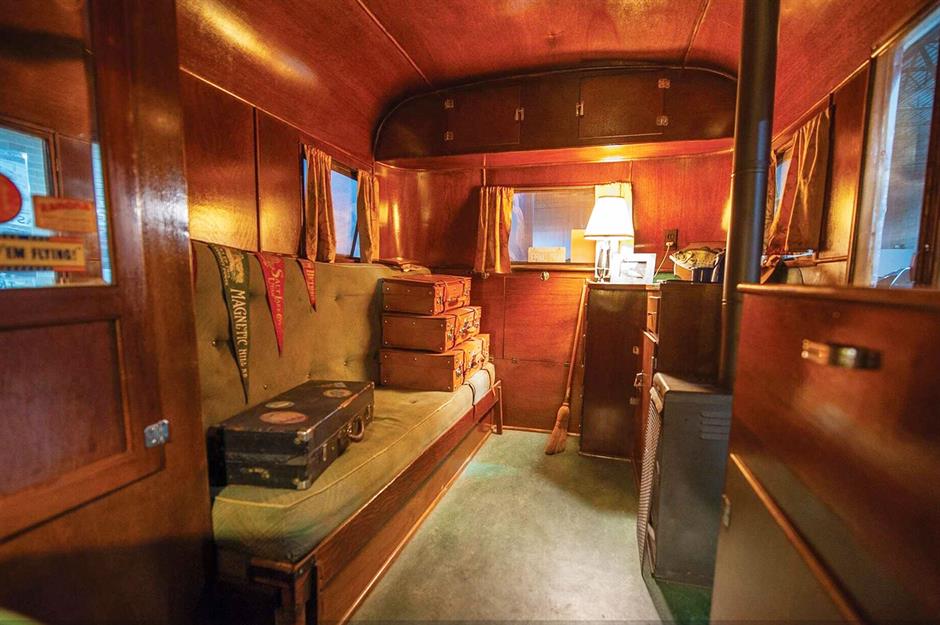
Darin Schnabel ©2019 Courtesy of RM Sotheby’s
The museum-quality specimen retains its original features and was sold with a range of period accessories, including a Philco wireless and vintage luggage set.
Travelodge models rarely come on the market, but Unique Classic Cars of Mankato, Minnesota listed a Model B earlier this year priced at $69,900 (£55.7k). Lamentably, the ravages of the Great Depression proved too much for Pierce-Arrow and the automaker went out of business in 1938.
Airstream Clipper (1936): the “aeroplane without wings”

Airstream
Arguably America’s most iconic trailer, the Airstream Clipper made its stunning debut in early January 1936. Airstream founder Wally Byam started the company from his backyard in Los Angeles in 1931, having spent much of his childhood working on a sheep farm and living in a wooden wagon towed by a donkey.
The game-changing Airstream trailer had a rival in the form of the aluminium riveted Bowlus Road Chief, which launched in 1934 and was designed by Hawley Bowlus, an aeronautical engineer who built the legendary Spirit of St Louis plane. While there are significant design differences between the two models both the Road Chief and Clipper drew heavily on the aircraft design of the time.
Airstream Clipper: the battle for production

Airstream
While Bowlus folded in 1936 with just 80 units produced (although the brand was revived in 2014), Airstream was also forced to pause production during the Second World War. When the conflict ended in 1945, Byam began manufacturing a line of travel trailers and re-opened the company.
The Clipper was priced from $1,465, around $32,000 (£25.5k) today, but had the edge over the competition. Out of the 400 companies producing RVs in the 1930s, Airstream was the only one that survived the Second World War.
Airstream Clipper: impressive amenities
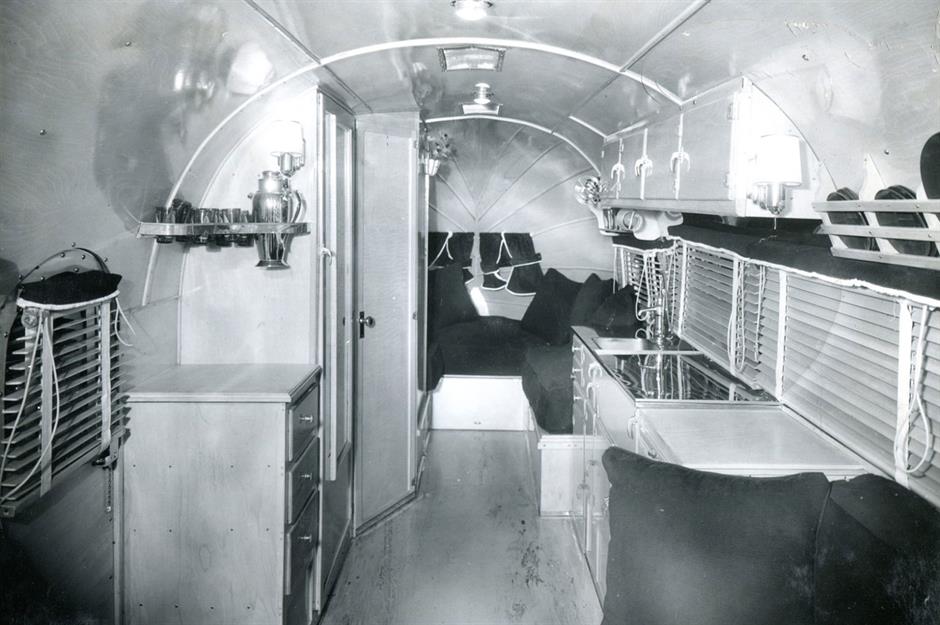
Airstream
The trailer’s superlative amenities proved to be hugely appealing too, since everything from a stainless-steel kitchen galley and wood cabinetry to a toilet, wireless and air conditioning was available for the wood-lined interior.
Airstream thrived in the postwar era as RVing hit the mainstream in the US, with the company’s models snapped up by multitudes of Americans, including politicians and Hollywood celebrities.
Shasta Airflyte (1961): canned ham-style trailer

Camarox66, Wikimedia Commons [CC BY-SA 4.0] ; Matt Cowan / Getty Images
Shasta started out in California in 1941 producing trailers for the US military. The company rode the crest of the postwar RV boom and by the late 1950s, it was producing trailers in vast quantities for the burgeoning mass market.
Shasta is famed for its canned-ham style trailers, also dubbed toasters-on-wheels. Standing out with their distinctive Z stripe and wings, which were added in the 1950s, the trailers were lauded for being relatively cheap, super-lightweight and surprisingly spacious. In 1961, Shasta launched the 15-foot Airflyte.
Shasta Airflyte: America’s one-time most popular trailer

George Rose / Getty Images
The trailer went down a storm with the American public and sold like hot cakes.
This especially snazzy example, which pops with that fabulous shiny aluminium, pink and white finish, was photographed in 2014 in Los Olivos, California. Not just pretty on the outside, Shasta Airflyte trailers have gorgeous interiors too.
Shasta Airflyte: 1960 interior and 2015 reissue

Visions of America, LLC / Alamy
Outfitted in fine birch or ash wood, the trailer packed in plenty of fancy features for the price, including a Formica table, comfy seating, a “King Size Luxury Lounge”, coordinated curtains, and more. Here’s the interior of a 1960 model.
The original Airflyte went out of production decades ago, but in 2015 Shasta reissued the 1961 version in two sizes priced between $15,000 (£12k) and $17,000 (£13.5k). Production was limited to 1,941 units, a nod to the year the company was founded.
Volkswagen T1 Camper (1950): pop culture icon

Theodore Trimmer / Shutterstock
An enduring pop culture icon like the Beetle car, the VW Camper was introduced in 1950 and went on to become the go-to for the hippies of the 1960s and 1970s, as well as untold RVers around the world.
The secret of the vehicle’s success lies in its simple yet head-turning design, remarkable dependability and boundless versatility, not to mention the affordable price tag. At its launch, the Camper cost the equivalent of $19,048 (£15k) in today’s money, not much more than the Beetle.
Volkswagen T1 Camper: sought-after Splitty

Matthew Richardson / Alamy
By 1967, almost 1.5 million Campers had rolled off the VW assembly lines in Wolfsburg, Germany. The OG T1 Campers, which are nicknamed Splitties on account of their split windscreen, became available in several sizes and variations.
Here’s a beautifully restored T1 that was manufactured in 1967. That same year, VW redesigned the vehicle and the split windscreen was swapped for a ‘bay window’. These days, the earlier Splitties are highly sought-after and sell for up to $82,000 (£65k) according to Classics World.
Volkswagen T1 Camper: vintage heaven
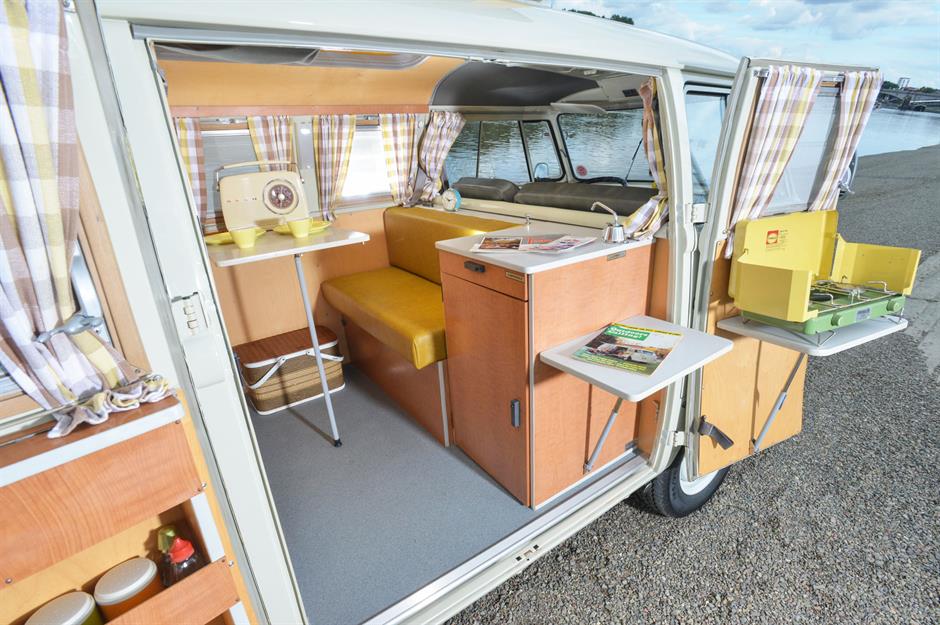
Matthew Richardson / Alamy
The immaculate pearl-white T1 is perfectly preserved with its original features intact. They include a fold-down bed in fetching mustard vinyl, a fold-down dining table, fridge, coat wardrobe and pop-up camper roof, with a retro radio and grill for added vintage appeal.
The price of this particular beauty was kept under wraps but a very similar T2 was sold recently by Park Bay Ltd in Washington State for $49,950 (£39.8k).
